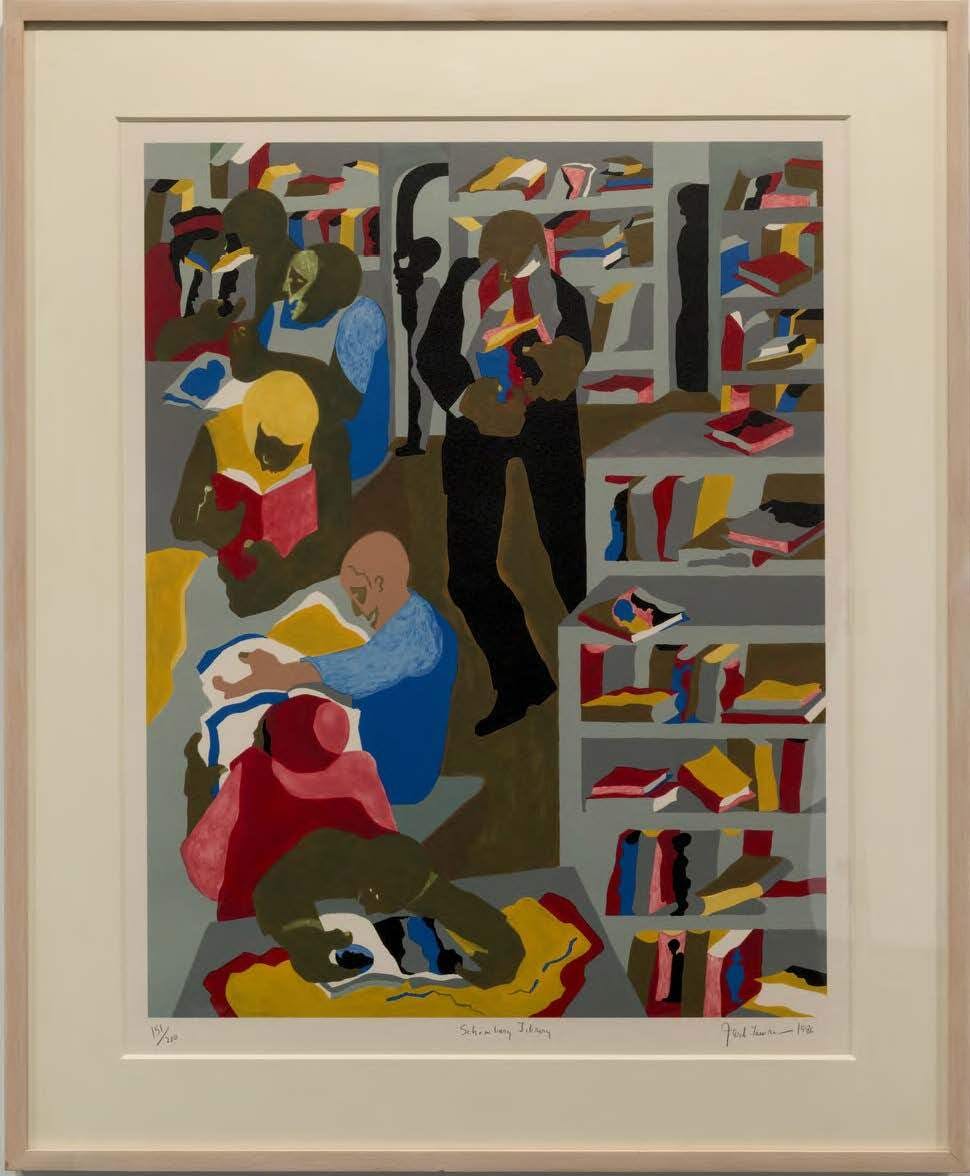Objective
Students will learn about the life of Jacob Lawrence and will discuss the importance of building a supportive community.
Born in New Jersey in 1917, Jacob Lawrence grew up in Harlem in the 1930s, experiencing both the Great Depression and a historic period of cultural and artistic innovation lead by Black artists and intellectuals, the Harlem Renaissance. Harlem was an active cultural center and as a teenager, Lawrence became interested in the arts while attending an after-school program, where he drew simple geometric patterns and made diorama-type paintings from corrugated cardboard boxes.

Jacob Lawrence, The Schomburg Library, 1986–87
At the Harlem YMCA, Lawrence met Charles C. Seifert, a Black, self-styled lecturer and historian who had collected a large library of African and African-American literature. Seifert encouraged Lawrence to visit the Schomburg Library in Harlem to read everything he could about African and African-American culture. Eventually Lawrence would spend hours in the library researching legendary Black figures and events to use in his paintings.
As the Great Depression worsened, Lawrence dropped out of high school to work and help support his family. By the late 1930s he took more art lessons at the Harlem Community Art Center and began painting his earliest Harlem scenes. His subject matter would expand to include the challenges endured by African Americans and the lives of important Black figures such as Harriet Tubman and Frederick Douglass. He also made several series of paintings about crucial events in the African American experience in the United States, such as the Great Migration from the South to the North.

Carl Van Vechten (1880–1964), Jacob Lawrence, from the portfolio “‘O, Write My Name’: American Portraits, Harlem Heroes,” 1941
Lawrence’s paintings express his lifelong concern with human dignity and freedom. His images portray the everyday reality, struggles, successes, and joys of African American life. His style is representational and combines vivid, often discordant tempera colors with a flattened, fragmented treatment of form and space. Lawrence said, “My pictures express my life and experience. I paint the things I know about and the things I have experienced.” Lawrence died in the year 2000.
Students will learn about the life of Jacob Lawrence and will discuss the importance of building a supportive community.
After reading the introductory text and looking at the artwork reproduction, think about:
Think about a place where you enjoy spending time. How do you remember it? What colors would you use to depict it? Follow the suggested prompts to create your own version of this place.
Diorama
A scenic, three-dimensional representation in which sculptured figures and lifelike details are displayed, usually in miniature, so as to blend indistinguishably with a realistic painted background.
Drop out
To withdraw from participation or membership, to quit; to withdraw from high school or before completing a course.
Expand
To increase the extent, number, volume, or scope of; to express at length or in greater detail.
Historian
An expert in history; a writer of history, a chronicler
Legendary
Of, relating to, or characteristic of legend or a legend; well known, famous.
Migrate
To move from one country, place, or locality to another.
Struggle
To proceed with difficulty or with great effort; to make strenuous or violent efforts in the face of difficulties or opposition.
Tempera
A type of paint made by mixing colored pigments with a water-based material such as egg yolk.
Treatment
Something (such as a product or technique) used in treating, enhancing, or improving the performance, condition, or appearance of a person or an object.
After reading the text, answer the following questions:
Crucial
Discordant
Endure
Flattened
Fragmented
Lifelong
Representational
Vivid
Worsen
experience, suffer, go through
broken, fractured, shattered
bright, colorful, lively
aggravate, deteriorate, damage
important, significant, decisive
flat, even, smoothed
continuing, long-lasting, permanent
dissonant, contradictory, different
authentic, graphic, figurative
Crucial: important, significant, decisive
Discordant: dissonant, contradictory, different
Endure: experience, suffer, go through
Flattened: flat, even, smoothed
Fragmented: broken, fractured, shattered
Lifelong: continuing, long-lasting, permanent
Representational: authentic, graphic, figurative
Vivid: bright, colorful, lively
Worsen: aggravate, deteriorate, damage
Take a closer look at the print and spend some time observing and noticing details:
Think about a place or places, other than school, where you go to learn about new things, and then write a paragraph or two about it or them. How did you learn about the place(s)? What do you like about it or them? What is the atmosphere like? Who goes there?
Click on the link below to learn about the Schomburg Center for Research in Black Culture. The video was made for its ninetieth anniversary. Consider how it impacted Lawrence when he was going there in the 1930s. Watch the whole video once, and if there are any words you didn’t understand watch it again with the closed captioning turned on.
https://www.youtube.com/watch?v=RI-_Ypgtw9Y
If you need more context, look up Harlem, the YMCA, the Great Depression, or the Harlem Renaissance to find out more about these places and this time period.
For additional practice, watch a second video about one of Lawrence’s series. Consider the historical events that informed these paintings. Watch the whole video once, and if there are any words you didn’t understand watch it again with the closed captioning turned on.